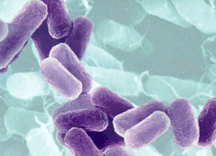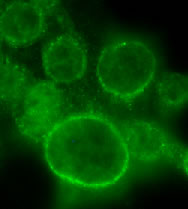

Transcription and RNA Polymerase II
Fong Lee
Chem 406 Web Termpaper
Fall, 2006
A. Home
B. Transcription
1. Initiation
2. Elongation
3. Termination
C. Contrast Eukayrotes and Prokaryotes
D. Amanitin
E. Kornberg and Stem Cells
F. Kornberg and other Biology
G. Reference


Eschericia coli [1] Transcritpion Factors [2]
Transcription is an important event that occurs in all living cells. The production of many vital proteins and many ribonucleic acid (RNA) depend on proper working transcription. Transcription is the process of converting the information (sequence of DNA) into an RNA sequence known as messenger RNA (mRNA). The whole transcription process can be explain in 3 processes. Each process is vital for the production of a mature mRNA. The 3 processes are initiation, elongation, and termination. Eukaryotic transcription occurs differently than prokaryotic transcription. However, both methods follow the same 3 processes and only differ in enzymatic proteins. During transcription the enzyme RNA polymerase binds to a specific region of the DNA called the promoter and causes the DNA to be unwound. This unwound portion of the DNA can be transcribe into mRNA and continues until termination. Termination occurs at a specific site in the DNA and releases the mRNA thus ending transcription.
Transcription Overview
The process starts with a gene (DNA form) of interest. RNA polymerase comes along and transcrips the antisense strand with complementry nucleotides begining the mRNA. For example:
5' ATGGGCCTGGACTTCATCGA 3' Sense strand
3' TACCCGGACCTGAAGTAGCT 3' Antisense strand
RNA polymerase and other factors transcribes the antisense strand into RNA molecules
5' AUGGGCCUGGACUUCAUCGA 3' New RNA strand previously transcribed(sense strand with U's replacing T's)
3' TACCCGGACCTGAAGTAGCT 3' Antisense strand
The 3 steps are shown in this figure below:
Intiation: This step allows RNA polymerase to bind to the gene at an area called the start region. Other transcriptional factors joins RNA polymerase and the DNA is separated (transcription bubble) for about 18 nucleotides. The first 3 nucleotide is added and this ends the intiation step.
Elongation: RNA polymerase continues and adds the remaining nucleotides to the growing mRNA strand and moves towards the stop site.
Termination: As the RNA polymerase grows a sequence towards the end of the gene qeues the RNA polymerase to stop and various other factors join in causing the cleavage of the mRNA. The transcription bubble disappears as the DNA re-hybridize.